Prize money $9,713,771 Siblings Paula Retired 2004 Height 1.75 m | Turned pro 1994 Role Tennis player Name Marcelo Rios | |
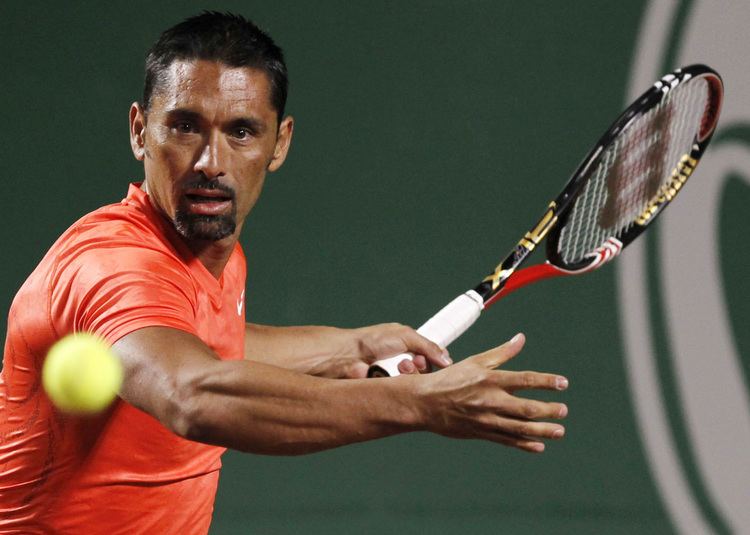 | ||
Born 26 December 1975 (age 49) Santiago, Chile ( 1975-12-26 ) Plays Left-handed (two-handed backhand) Spouse Paula Pavic (m. 2009), Maria Eugenia Larrain (m. 2005–2008), Giuliana Sotela (m. 2000–2004) Children Colomba Rios, Agustina Rios, Marcelo Jr. Rios, Isidora Rios, Constanza Rios, Antonella Rios Parents Alicia Mayorga, Jorge Rios Jarvis Similar People Nicolas Massu, Fernando Gonzalez, Maria Eugenia Larrain, Gustavo Kuerten, Thomas Muster | ||
AO Classics: Marcelo Rios v Tommy Haas (2002 QF)
Marcelo Andres Ríos Mayorga (born 26 December 1975) is a former world No. 1 tennis player from Chile. Nicknamed El Chino ("The Chinese") and El zurdo de Vitacura ("The Lefty from Vitacura"), he became the first Latin American player to reach the top position on the Association of Tennis Professionals (ATP) singles rankings in 1998. He held the No. 1 ranking for six weeks. He also held the top ranking in both juniors and seniors. He was the first player to win all 3 clay-court Masters Series tournaments (Monte Carlo, Rome, and Hamburg) since the format began in 1990. Despite winning five Masters titles overall, he is the only male player in the open era to have been world No. 1 while never managing to win a Grand Slam singles tournament in his career. He did reach the 1998 Australian Open final, losing to Petr Korda in straight sets. Until Rafael Nadal in 2008, Ríos was the last left-handed player to become world No. 1.
Contents
- AO Classics Marcelo Rios v Tommy Haas 2002 QF
- Alex corretja vs marcelo r os final roma 1997
- Tennis career
- Early years
- Junior career
- 1994
- 1995 Breakthrough
- 1996 Top 10 debut
- 1997 Impending dominance
- 1998 World No 1 in singles first Grand Slam final
- 1999 Continued success beginning of injuries
- 2000 Persistent injuries loss of form
- 2001 Inevitable decline
- 2002 Struggles
- 2003 Long absence from tour out of Top 100
- 2004 Retirement from main tour
- 2006
- 2007
- 2008
- Personal life
- Controversies
- Doubles 2 1 title 1 runner up
- Singles
- Records
- References
He retired prematurely in July 2004, after being overtaken by a back injury. He played his last ATP Tour level tournament while only 27 years old at the 2003 French Open.
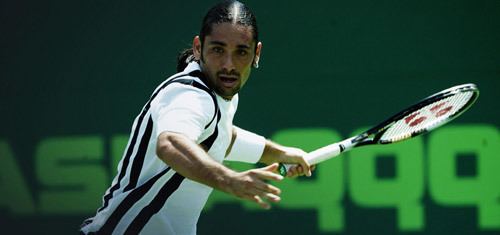
Alex corretja vs marcelo r os final roma 1997
Tennis career
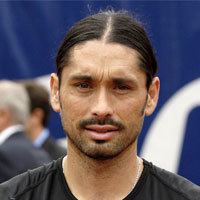
Ríos turned professional in 1994, finishing 1997, 1998, and 1999 as a top 10 player. Ríos won a total of 18 top-level singles titles and 1 top-level doubles title during his career.
Early years
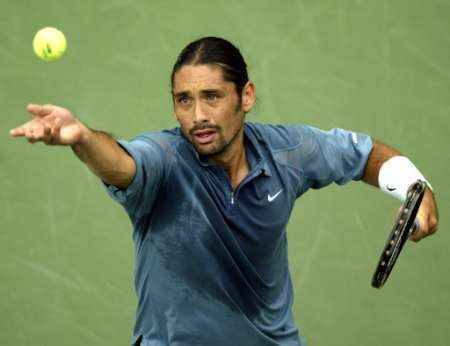
Ríos began playing tennis at the age of 11 at the Sport Francés golf club in Vitacura (Greater Santiago), adjacent to his house.
Junior career
As a junior, Ríos reached as high as No. 1 in singles and No. 141 in doubles.
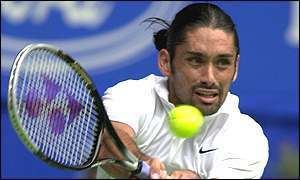
Ríos reached the semifinals of the junior French Open in 1993 without dropping a set, where he was defeated by Roberto Carretero-Diaz in straight sets, and won the junior US Open in 1993 while only dropping 1 set during the entire tournament. He also won his first satellite tournament in Chile.
1994
This was Ríos' first year being a professional player and he quickly began to acquire international fame after his participation at Roland Garros, where in the second round, at just 18 years of age, he confronted Pete Sampras, fighting a hard battle eventually to lose 6–7(5–7), 6–7(4–7), 4–6. His great left-handed ability, plus his novel long hair and backwards visor, drew the attention of the media, marking his first step towards international stardom. The same year he won his first Challenger in Dresden, Germany.
1995: Breakthrough
In May 1995, aged 19, Ríos won his first tournament title in Bologna defeating Marcelo Filippini of Uruguay 6–2, 6–4, and breaking into the world's top fifty for the first time. Then in June he won at Amsterdam in both singles (against Jan Siemerink, 6–4, 7–5, 6–4) and doubles (with Sjeng Schalken) and won the tournament in Kuala Lumpur against Mark Philippoussis 7–6, 6–2. He also reached the final of his home country's ATP tournament in Santiago. Ríos ended the year ranked No. 25 in the world.
1996: Top 10 debut
Ríos' achievements this year included excellent performances in the Masters Series (then called Super 9) tournaments. He reached the quarterfinals in Masters Series of Stuttgart and Rome, and the semifinals in Indian Wells, Monte Carlo, and Canada. In Sankt Pölten, Austria, he won his fourth career title by defeating the Spaniard Félix Mantilla 6–1, 6–4. Ríos again reached the final in Santiago (where a sort of curse seemed to deny him victory in front of his home crowd), and also reached the finals in Barcelona and Scottsdale. For much of the year Ríos would be ranked in the top ten, becoming the first Chilean in history to do so. He finished the year ranked number 11.
1997: Impending dominance
In 1997 for the first time in Ríos' career he reached the quarterfinals of a Grand Slam tournament at the Australia Open and again at the US Open. He also won his first Masters title at Monte Carlo; after a first round bye, he beat Andrea Gaudenzi, Albert Costa, Carlos Moyá, Magnus Larsson, and, in the final, Àlex Corretja, 6–4, 6–3, 6–3. Two weeks later he lost in the final of the Rome Masters against the same Spaniard. Other successes for the year included the quarterfinals (again) in the Stuttgart Masters and the finals in Marseille, Boston, and (for the third time) in Santiago. Ríos had a very consistent 1997 season, being the only player to reach 4th round or better on all Grand Slams. Ríos went as high as No. 6 during the year, and ended the year in the top ten for the first time, being No. 10.
1998: World No. 1 in singles, first Grand Slam final
The year 1998 brought the peak of the career of Ríos, who reached the number 1 spot in the world. The year began with success. He won the tournament (the first of the year) in Auckland, New Zealand, against Richard Fromberg, then reached the final of the Australian Open, losing to Petr Korda in a lopsided 2–6, 2–6, 2–6 that lasted 1 hour and 25 minutes. The following months brought successes such as the title of the Super 9 (the current Masters Series) at Indian Wells, where he defeated hard-serving Brit Greg Rusedski in the final.
The consummation came in the final at Key Biscayne Masters, Florida, under the guidance of his coach Larry Stefanki. After victories over Hendrik Dreekmann, Tommy Haas, and Goran Ivanišević, Ríos beat Thomas Enqvist in the quarterfinals and Tim Henman in the semis. In the final on March 29, Ríos defeated Andre Agassi 7–5, 6–3, 6–4. In Chile, thousands of people took to the streets to celebrate the triumph of the first Chilean to reach the sport's number one ranking, grabbing the position from Pete Sampras (who had maintained 102 consecutive weeks at number one, and 5 years ending the season as the leader). In the days ahead, there was a crowded reception leading Ríos to then president Eduardo Frei Ruiz-Tagle on La Moneda Palace, with around 10,000 people cheering at the palace's surroundings. Ríos' number one ranking lasted four weeks; he lost it after being unable to defend the title at Monte Carlo because of an injury suffered in the Davis Cup while defeating Hernán Gumy in Buenos Aires, Argentina. In May he reached the quarterfinals of the French Open losing to eventual champion Carlos Moyá. His excellent performance at the two first grand slams turn into disappointment at the next two. In June, at Wimbledon, Marcelo was upsetted at first round by Spaniard Francisco Clavet. On August 10, however, Ríos recovered the number one spot for another two weeks. In September he loses at third round of the U.S Open to Magnus Larsson. During this extraordinary season Marcelo also won the Rome Masters against Albert Costa by walkover in the final, Sankt Pölten beating Vincent Spadea, the Grand Slam Cup against Andre Agassi, and Singapore against Mark Woodforde. Furthermore, he reached the quarterfinals in the Stuttgart Masters and Paris Masters. The year 1998 was a milestone in the career of Marcelo and also sport in Chile. Ríos won 7 titles, including 3 Masters Series titles, and reached the final of the Australian Open. On July 27 of that year, he reached the maximum number of points achieved throughout his career: 3719 (by the scoring system used prior to the year 2000). He ended the year ranked No. 2 behind Pete Sampras, who topped the world rankings for a sixth consecutive year.
1999: Continued success & beginning of injuries
Ríos maintained a high level throughout 1999, although his game was interrupted by repeated injuries and surgeries. This prevented him from defending the points achieved by reaching the final of the Australian Open the previous year, so he fell several places in the rankings. He reached the final of the Monte Carlo Masters, but after trailing 4–6, 1–2, he had to retire due to a new injury, handing the tournament to Gustavo Kuerten. Ríos subsequently won the Hamburg Masters in a match that lasted more than four hours against Argentine Mariano Zabaleta; 2 weeks later he became champion in Sankt Pölten for the second consecutive time against the same Argentine, who, this time, had to retire during the first set at 4–4. In October, he won at Singapore and reached the final in Beijing, losing to the Swede Magnus Norman. He also reached the quarterfinals at Roland Garros and the Stuttgart Masters. Despite many injuries he suffered and surgeries he underwent, Ríos would complete his third consecutive year as a top 10 player, at world No. 9.
2000: Persistent injuries & loss of form
Since the very beginning of the 21st century until the end of Ríos' career on the main tour he was not able to keep up his level of play to the standards he set in the 90s, as it was marked by repeated and disabling injuries that would prevent Ríos from staying amongst the top players in the world. He still won the tournament of Umag, Croatia beating the Argentine Mariano Puerta in the final. Ríos also reached the semifinals at the Hamburg Masters losing to Marat Safin, one of the new stars of the circuit and a future world No. 1. Ríos finished the year No. 37 in the world.
2001: Inevitable decline
In 2001 Ríos won the first tournament of the year in Doha. However, his performance in the following tournaments was weaker, weakened by an ankle operation, which resulted him to drop out of the top 50 in the world for the first time since he was a teenager. In September Ríos won another title, this time in Hong Kong, defeating German Rainer Schüttler in the final. Ríos decided to return in October to play a Challenger tournament, winning the final of Santiago beating the Argentine Edgardo Massa in the final. He also reached a doubles final in Scottsdale. Ríos ended the year as No. 39 in the world.
2002: Struggles
In early 2002 he had some good results, but a back injury prevented him from continuing the season successfully. It was the same injury that he had had two operations with already, and finally prevented him from returning to a competitive level. His best results were the quarterfinals at the Australian Open, the semifinal at the Miami Masters, and the final in the Stockholm tournament playing the Thai Paradorn Srichaphan. Ríos would finish Top 25 in the world for the first time since 1999 at No. 24, but without managing to recover from injuries that beset him since late 1999.
2003: Long absence from tour & out of Top 100
In Viña del Mar tournament (formerly Santiago tournament) Ríos reached the final, losing to Spaniard David Sánchez. This is fourth of the four finals he participated and lost in his home country. However, representing Chile together with Fernando González and Nicolás Massú, he won the World Team Cup in Düsseldorf. The same year he also won silver medals in singles and doubles with Adrián García in the 2003 Pan American Games. In May Ríos played his last ATP-level match, losing in the first round at Roland Garros to Mario Ančić after retiring at 1–6 0–1. In 2003 Ríos played very few tournaments, in most of which he had to withdraw. This resulted him ending the year as No. 105 in the world, his worst year-end ranking on the main tour yet.
2004: Retirement from main tour
In 2004, six years after claiming the World No. 1 ranking, and after a long absence from the tour, Ríos returned to competition with a 6–0, 6–0 victory at a Challenger Series tournament in Ecuador. He played his last competitive match in early April 2004 at a Challenger in San Luis Potosí, Mexico, where he retired in the round of 16.
Finally, on July 16, 2004, after years of constant injuries and back discomfort—and at just 28 years old—Rios announced his retirement from tennis during a press conference in Santiago. He organized a farewell tour across his home country, travelling through several cities, meeting with fans, offering tennis clinics, and playing friendly matches with international and local tennis players such as Petr Korda and Goran Ivanišević. The tour ended on December 22, 2004, at a soccer stadium in Santiago, where he played his final tennis match of his career on the main tour against Guillermo Coria of Argentina.
2006
On March 29, 2006, Ríos, aged 30, debuted on the ATP Champions Tour, a tour for former tour players, having met the requirement of at least 2 years after retirement. At his first tournament on the tour in Doha, Qatar, he defeated Thomas Muster, Henri Leconte, Pat Cash, and Cédric Pioline to claim the title. The following week he repeated, this time winning the crown in Hong Kong, where he won the final against former world No. 1 Thomas Muster. Rios won six tournaments in a row, adding Algarve, Graz, Paris and Eindhoven to the above. His inclusion on the senior circuit caused mild controversy, as he was significantly younger than many of his fellow competitors. He ended the year as No. 1, winning a total of six tournaments and holding a winning streak of 25 matches, achieving the record of being the only player in history to be No. 1 in the world as a junior, professional and veteran.
2007
Ríos did not take part in the Champions Tour in 2007.
Ríos actually intended to return to the main ATP Tour in February at the Viña del Mar tournament (Movistar Open), but he defaulted because of the same back injury that made him retire from the tour.
On March 30, 2007, Ríos played an exhibition match in the Movistar Arena against Andre Agassi, both as a way to commemorate the match where Ríos rose to world No. 1 and as a way of having the American play in Chile.
2008
In 2008 Ríos came back to veteran's tour where he won the tournaments in Barcelona and Algarve. On June 22, 2008, he was defeated by Pete Sampras in the final of a seniors tournament in São Paulo, Brazil. Ríos ended the year as No. 3 in the veteran's world rankings.
On June 24, 2008, Ríos defeated Pete Sampras in an exhibition match that commemorated the ten years anniversary of having reached the Number 1 ranking in the world.
Personal life
Ríos was born in Santiago, Chile to Jorge Ríos Jarvis, an engineer and businessman, and Alicia Mayorga, a teacher. He has an older sister, Paula.
Ríos met Costa Rican Giuliana Sotela in September 1998 while he was training at the Nick Bollettieri Tennis Academy in Florida. Ríos and Sotela got married in December 2000 in Santiago. They have a daughter, Constanza, who was born in June 2001. In March 2004, the marriage ended in divorce, which legally took place in Costa Rica, as Chile did not allow married couples the right of divorce until November 2004. During 2004, Ríos worked as a sports commentator for a radio station in Chile.
In April 2005, Ríos married model María Eugenia "Kenita" Larraín, a former fiancée of football player Iván Zamorano. The couple subsequently experienced a very public break-up in September of the same year after an incident in Costa Rica in which Larraín was injured when Ríos allegedly threw her out of his car while he was driving to visit his daughter. Ríos claimed that marrying Larraín was "the biggest mistake of my life."
In May 2008, Ríos married Paula Pavic. They have five children together, daughter Isidora (born December 2008), daughter Colomba (born June 2010), and also triplets, which are a son named Marcelo Jr. and two daughters named Antonella and Agustina (all born December 2011).
In March 2008, on the tenth anniversary of Ríos reaching the Number 1 ranking, journalist Nelson Flores published a book in Spanish titled El extraño del pelo largo ("The strange man with long hair"), recounting his experiences following the player from his junior days up to his ascent to the top of the ATP singles ranking.
In November 2011, an English-language book was published by Mark 'Scoop' Malinowski about Rios, Marcelo Rios: The Man We Barely Knew.
In May 2014, Ríos claimed in an interview to El Mercurio that he could be a sufferer of Asperger syndrome. On 17 November 2016, Ríos confirmed in an interview to Chilevisión that he was diagnosed with Asperger twice in his life, as a kid an during a Davis Cup tie, but he didn't care that much until the 2014 interview.
Controversies
Ríos' career was marked by a number of controversies.
Doubles: 2 (1 title, 1 runner-up)
Singles
Davis Cup matches are included in the statistics. Walkovers are neither official wins nor official losses.
1At the 1998 ATP Tour World Championships (Tennis Masters Cup), Ríos withdrew at round robin stage after playing the first match. He was replaced by then world No. 11 Greg Rusedski.
2At the 1998 Eurocard Open (Stuttgart Masters), Ríos withdrew prior to quarterfinals.
3At the 2001 Monte Carlo Masters, Ríos withdrew prior to second round.
